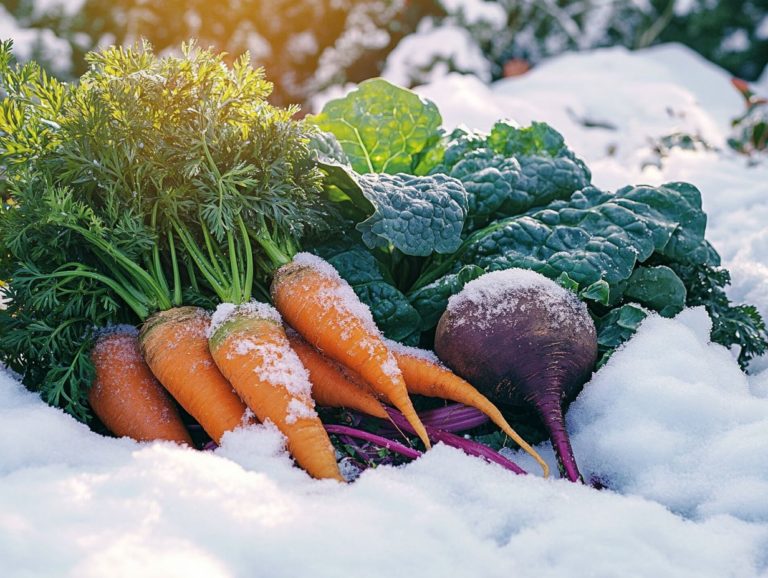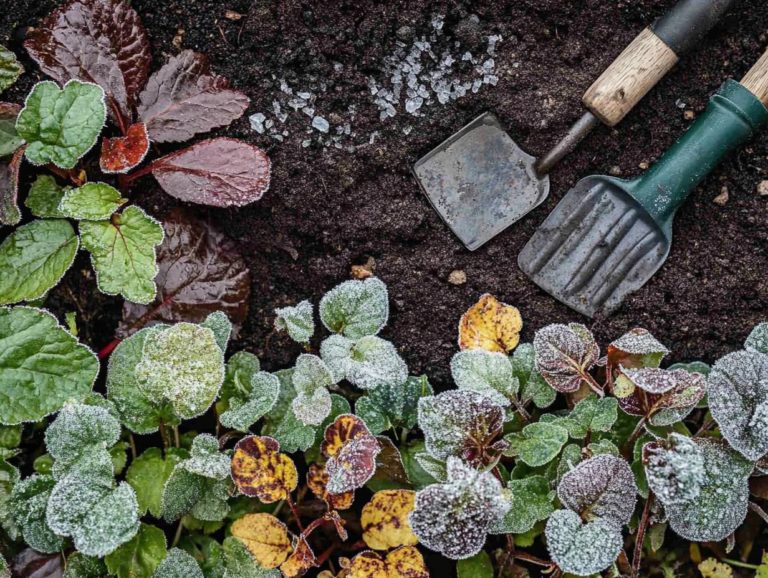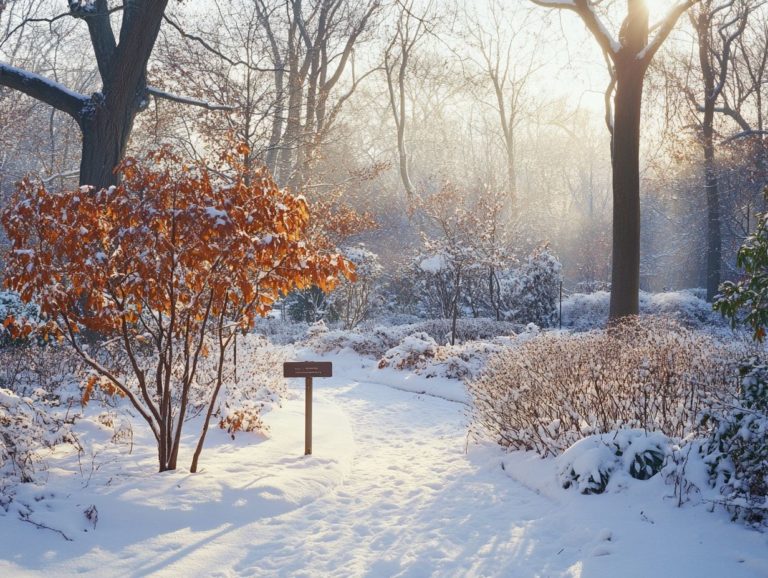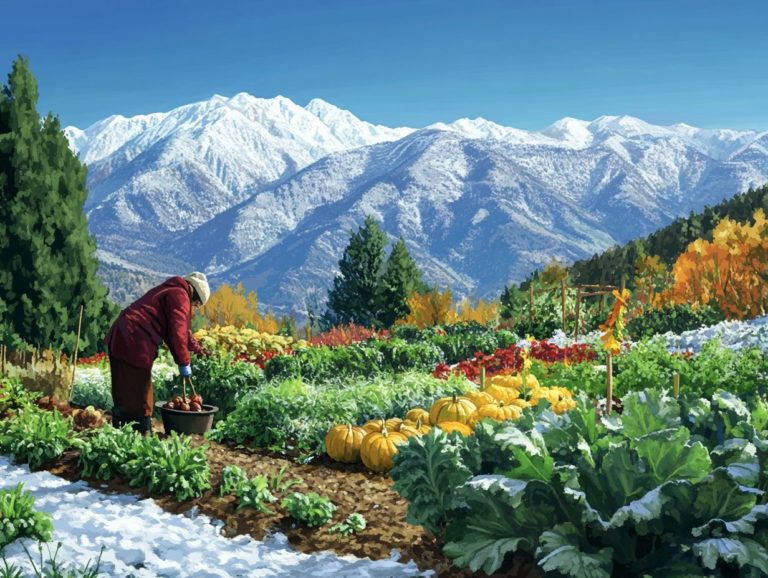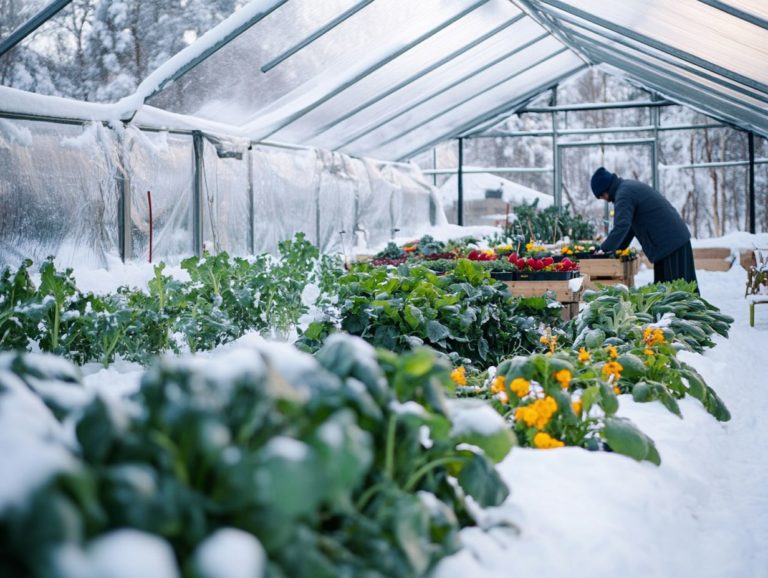How Can I Protect My Plants from Frost?
Frost can be a gardener’s worst enemy. It disrupts the beauty of your landscape and damages delicate plants.
For any gardening enthusiast, knowing what frost is and how it harms plants is crucial. Discover powerful strategies to protect your plants from frost and keep your garden thriving!
You’ll learn how to prepare your plants before frost makes its unwelcome arrival. Additionally, find out how to revive those that have already suffered.
With long-term solutions like creating microclimates and using protective coverings, you can effectively shield your garden from the chill.
Contents
- Key Takeaways:
- Understanding Frost and Its Effects on Plants
- Preventing Frost Damage
- Preparing Plants for Frost
- Dealing with Frost Damage
- Long-Term Strategies for Protecting Plants from Frost
- Frequently Asked Questions
- How Can I Protect My Plants from Frost?
- What is a frost blanket and how does it protect plants from frost?
- How often should I water my plants to protect them from frost?
- Is it better to cover individual plants or group them together to protect from frost?
- What are some natural ways to protect plants from frost?
- Are there any preventative measures I can take to protect my plants from frost?
Key Takeaways:
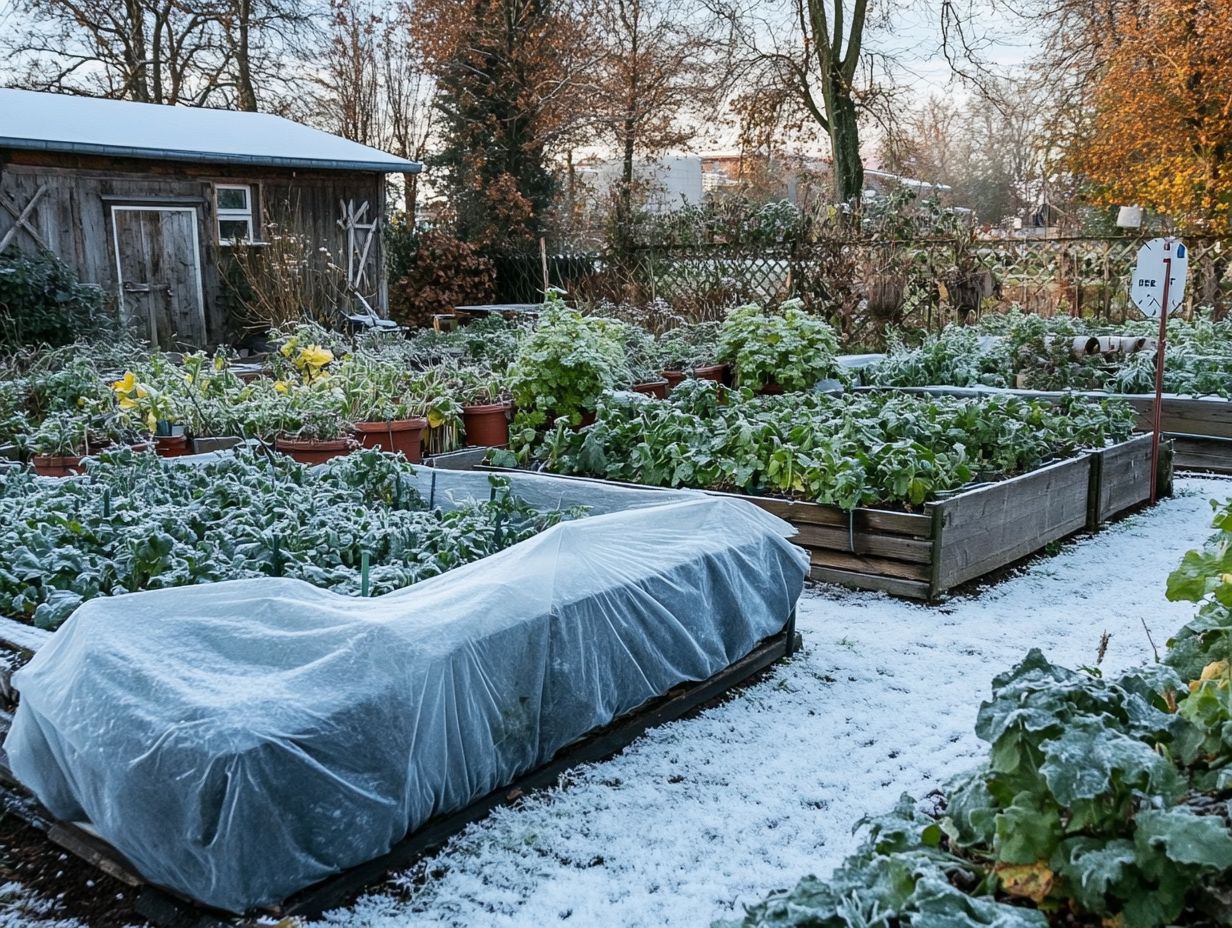
- Understand the effects of frost on plants and how it damages them. This will help you take preventive measures to protect your plants.
- Take necessary steps before frost arrives, such as covering plants or creating microclimates, to minimize damage and increase chances of revival after frost.
- Choose the right plants for your climate and use long-term strategies like creating microclimates and using protective coverings to protect your plants from frost.
Understanding Frost and Its Effects on Plants
Knowing frost and its impact on plants is essential for you as a gardener committed to preserving the integrity of your cherished garden beds and container gardens.
Frost can wreak havoc, particularly on tender and young plants, including tropical varieties and vegetable crops. These are often hit hard by the freezing temperatures.
By understanding how frost affects your plants, you equip yourself to take preventive actions, fostering a healthier and more resilient garden ecosystem.
What is Frost and How Does It Damage Plants?
Frost is an intriguing meteorological phenomenon where temperatures dip below freezing, leading to the formation of ice crystals on plant surfaces. This can result in significant damage to various types of plants.
There are several types of frost to be aware of, such as radiation frost and advective frost. Each has its unique effects on your plants. Radiation frost occurs on clear, calm nights when heat escapes rapidly from the earth, causing localized freezing temperatures. In contrast, advective frost happens when warmer air is displaced by cold air, leading to a more widespread cooling effect.
These frosts can manifest in distressing symptoms: wilting, leaf discoloration, and even the death of tender stems in outdoor plants. Indoor species aren t spared either; they may experience slowed growth and leaf drop.
By understanding the specific impacts of Jack Frost, you can take proactive steps to protect vulnerable varieties, ensuring a healthier and more resilient garden.
Preventing Frost Damage
Preventing frost damage is crucial for maintaining the health and vigor of your plants, particularly for young, tender, and tropical varieties that are especially vulnerable to cold weather.
To effectively shield your plants from frost, consider utilizing insulating materials like fleece covers, implementing cold frames, and applying a layer of mulch around your plants to help retain soil warmth. For more detailed strategies, refer to this guide on how to protect your plants from frost. This proactive approach will ensure your plants thrive, even in chilly conditions.
Protective Measures for Plants
Implementing effective protective measures can significantly reduce the risk of frost damage, helping you learn how to create shelter for sensitive plants and ensuring their survival during chilly spells.
By utilizing frost cloths, fleece covers, and cozy blankets, you can create a barrier that traps warmth and shields delicate foliage from the harsh elements. Additionally, consider relocating vulnerable plants to more sheltered spots, like against a warm wall or beneath a tree. For more tips, check out this guide on how to protect your plants in cold weather. This simple move can provide invaluable protection against biting winds and extreme temperatures.
Creating microclimates, or small areas with a different climate than the surrounding area, helps your plants thrive in warmer conditions. This not only enhances their resilience but also promotes healthy growth throughout the changing seasons. These practices are essential for nurturing your plants and preserving their vitality during those frosty nights.
Don t let frost ruin your hard work! Dive in to learn how to keep your plants flourishing through the cold.
Choosing the Right Plants for Cold Climates
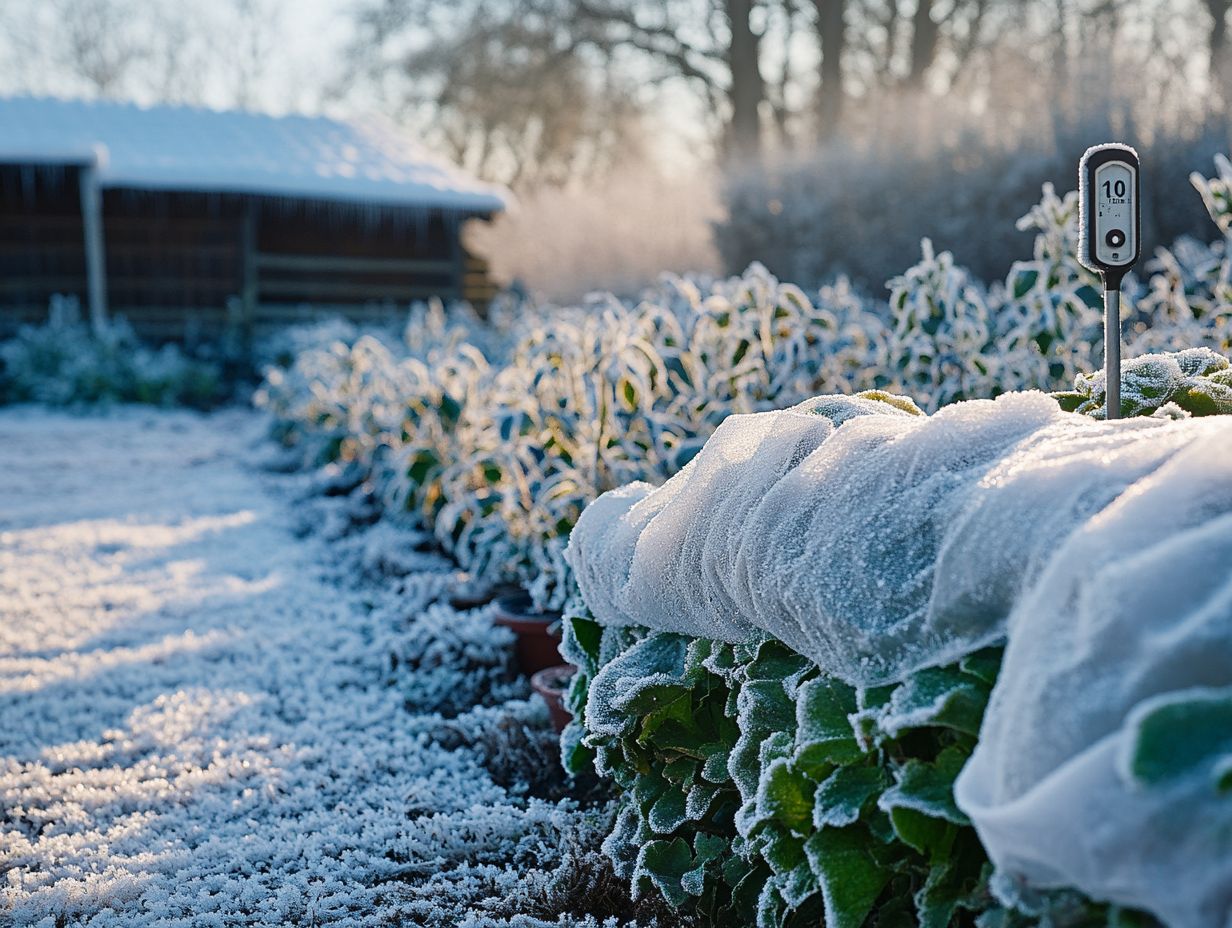
When gardening in cold climates, selecting the right plants is essential for your garden to thrive. Choose hardy perennials and other varieties that thrive in the cold.
Take hydrangeas, for example; they’re celebrated for their breathtaking blooms and can withstand frost with the right care, particularly the panicle and smooth species. Agapanthus, often thought to prefer warmer climes, can surprise you by adapting to cooler regions when adequately sheltered during the harshest winters.
To boost their resilience, consider adding mulch to keep the plants warm around their base for insulation. Place them in sheltered areas to minimize frost exposure. By focusing on these durable options, you can cultivate a vibrant landscape year-round, regardless of the challenges that cold weather presents.
Preparing Plants for Frost
Preparing your plants for frost requires several essential steps that will safeguard them from the impending cold and enhance their resilience.
Start by ensuring that your plants are properly hydrated, ideally by watering them in the morning. This simple action, combined with applying a layer of mulch for insulation, significantly boosts their chances of surviving those chilly nights ahead.
Steps to Protect Your Plants
Before frost sets in, it s crucial for you to take certain steps to protect your plants and ensure their resilience through the cold season.
Begin by examining the upcoming weather forecasts to anticipate any potential frost events. If temperatures are predicted to drop significantly, consider watering your plants in the morning; this simple act can enhance their chances of enduring the overnight chill.
A thick layer of mulch around the base of your plants will serve as a protective blanket for their roots against freezing temperatures. For your potted plants, which may be more susceptible, covering them with cloths or moving them indoors can truly make a difference.
These simple strategies can save your plants and keep your garden vibrant this winter!
Dealing with Frost Damage
Navigating frost damage presents a unique challenge in gardening, especially for those nurturing tender plants and tropical varieties. Learn how to assess the extent of the damage and apply effective revival strategies.
This knowledge is key to keeping your garden thriving and healthy.
How to Revive Damaged Plants
Reviving frost-damaged plants requires a blend of gentle care and specific gardening techniques finely tuned to each plant’s unique needs.
Understanding the distinct characteristics of the affected plants is vital for successful rehabilitation. For example, they may thrive with adjusted watering methods keeping the soil consistently moist but not waterlogged can greatly support their recovery.
Temperature management is equally crucial; shielding your plants from harsh winds and abrupt temperature changes can foster a more favorable microclimate. Pruning away any dead or severely damaged foliage not only enhances the visual appeal but also spurs new growth.
Incorporating mulching practices can protect root systems while retaining moisture, further aiding in the recovery journey.
When to Remove Damaged Plants
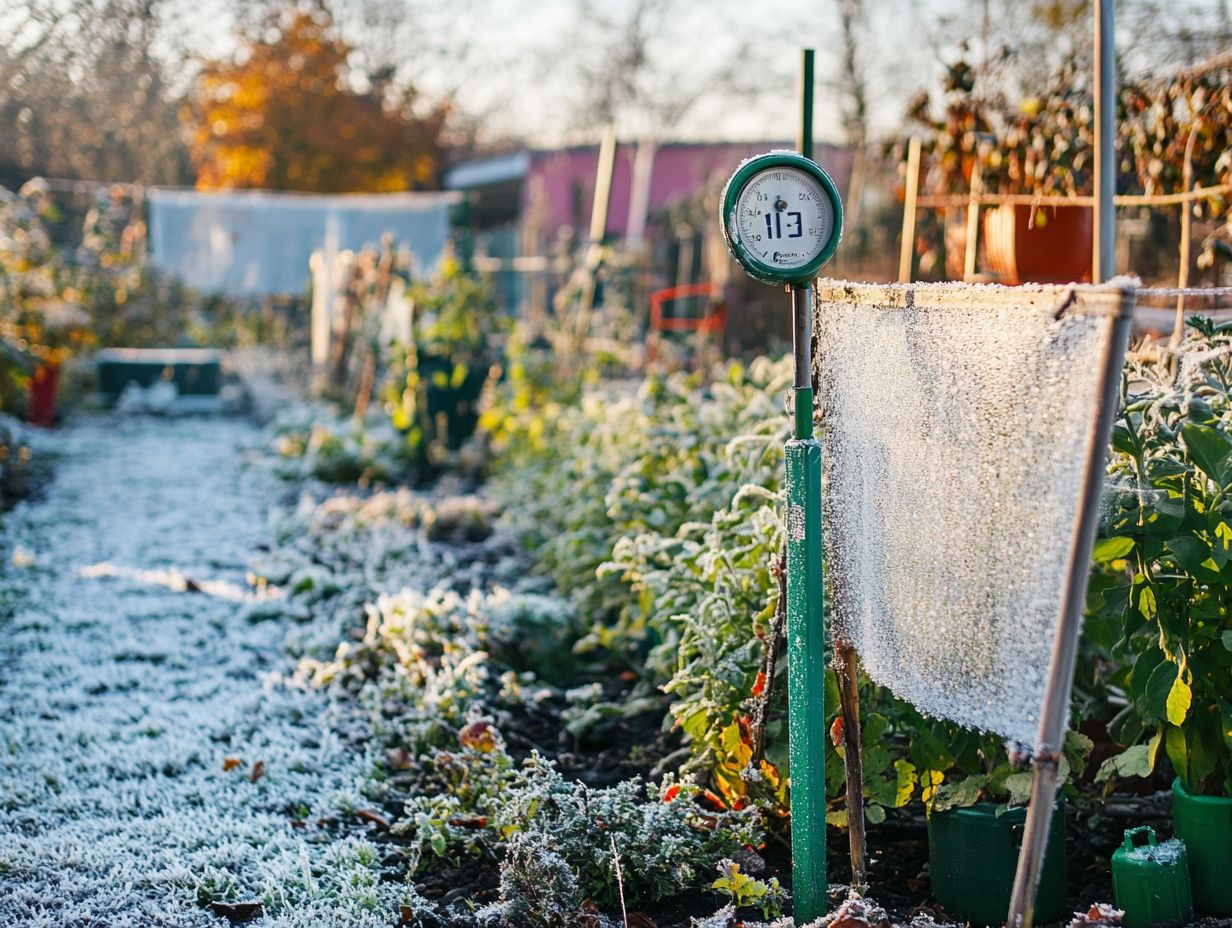
Knowing when to remove frost-damaged plants is a pivotal decision, especially if you aim to maintain a thriving garden ecosystem.
Begin by understanding the signs of frost damage and assessing the condition of your plants. Start with a close examination of the leaves look for discoloration, wilting, or a mushy texture. These are clear indicators of severe damage.
Don t overlook the stem either check for brown or black spots and whether it still feels firm and healthy. If the roots show signs of distress, such as dark, mushy spots or a foul odor, the plant may be beyond saving.
On the other hand, if only parts of the plant are affected while other sections remain robust, consider a careful pruning strategy to encourage new growth.
Ultimately, the overall vigor of the plant after frost should guide your decision on whether to nurture it back to health or remove it entirely. This ensures your garden continues to thrive and flourish.
Long-Term Strategies for Protecting Plants from Frost
Protect your plants from frost by using smart, long-term strategies. Learning how to protect roots from freezing not only safeguards your young and tender plants but also enhances the overall resilience of your garden.
By creating small areas with different weather conditions and utilizing covers that protect plants, you can employ effective techniques that contribute to a healthier ecosystem.
This ensures that your gardening efforts continue to yield fruitful results, even in the chill of colder climates.
Creating Microclimates
Creating small areas with different weather conditions in your garden is a brilliant strategy to safeguard your plants from frost and elevate their growth potential in diverse climates.
By thoughtfully utilizing natural features, you can craft unique environments that greatly enhance plant health and productivity.
For example, consider establishing windbreaks using hedges or fencing to protect delicate plants from harsh winds. South-facing slopes capture maximum sunlight, allowing sun-loving varieties like tomatoes and peppers to truly flourish.
Using walls or fences that absorb heat during the day can generate warmer zones perfect for more sensitive species, such as lavender or certain fruit trees.
Each of these customized areas gives you the power to cultivate a broader array of plants, enriching the biodiversity and visual appeal of your garden.
Using Protective Coverings
Using protective covers is one of the most effective ways to shield your plants from frost damage, especially for young and tender varieties. For more detailed strategies, check out how to protect your crops from freezing.
Among the many options, fleece covers stand out as an excellent layer that keeps warmth in. They allow sunlight to filter through while retaining warmth, making them especially valuable during unexpected cold snaps.
Frost cloths offer a more breathable alternative, providing protection without trapping moisture that could lead to mildew.
It s crucial to consider the specific needs of each plant type when selecting a covering. Some may require heavier protection to endure harsh winter conditions, while others flourish with lighter fabrics.
Proper application techniques are equally important; securing the coverings at the base prevents wind uplift and maximizes protection, promoting healthier growth and resilience against environmental stressors.
Frequently Asked Questions
How Can I Protect My Plants from Frost?
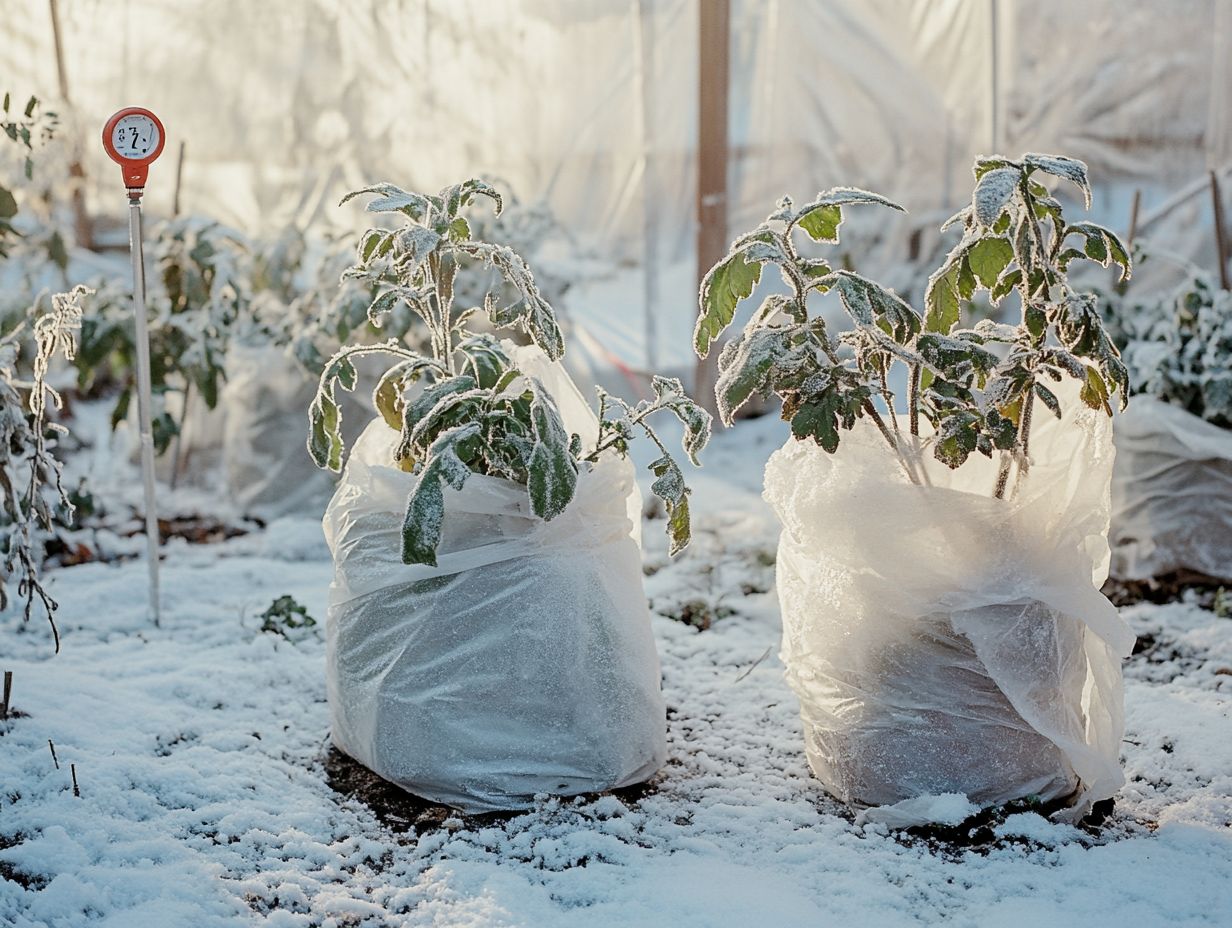
- Use frost blankets.
- Water the soil.
- Group plants together.
What is a frost blanket and how does it protect plants from frost?
A frost blanket is a lightweight fabric that can be draped over plants to provide insulation and protect them from frost. It traps heat from the soil and prevents frost from forming on the plant’s leaves.
Start protecting your plants today! Your garden will thank you.
How often should I water my plants to protect them from frost?
Water your plants before a frost to give them a fighting chance. Focus on watering the soil, not the leaves. Water will freeze on leaves, causing damage. Moist soil provides insulation for the roots.
Is it better to cover individual plants or group them together to protect from frost?
Group plants together for better frost protection. Together, they create a warmer area, reducing frost exposure. Individual plants remain at risk, even with a frost blanket.
What are some natural ways to protect plants from frost?
Use natural materials like mulch, straw, or pine needles around your plants. These insulators keep the soil and roots warmer during frost.
Are there any preventative measures I can take to protect my plants from frost?
Yes! Choose cold-hardy plants that withstand frost better. Plant them in sheltered spots, like near a wall or under a tree, for extra protection. Avoid over-watering to keep your plants strong against the cold.

